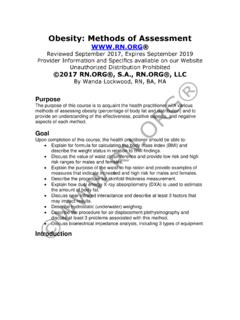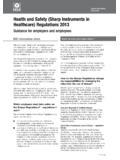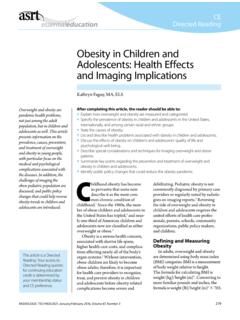Transcription of Shawn Wells R.D. - bio-dl.s3.amazonaws.com
1 2 Shawn Wells FooDS ThaT FighT ViSceRal Belly FaTIn 1947, French professor and physician Jean Vague first reported in a French medical journal clinical observations that patients with a host of health issues ( , hypertension, gout, diabetes) were not necessarily more obese than his patients without such Despite not having access to sophisticated tools, Vague identified two different body shapes representing two distinct ends of the obesity spectrum: Android obesity, which refers to excess fat stored preferentially in the trunk/upper body area. It s this pattern of fat storage that Vague identified being closely associated with diabetes and heart disease. Gynoid obesity, which refers to preferential fat storage in the hips and thighs. This is frequently described as female obesity, and it is less associated with the complications of android and gynoid obesities have also been commonly referred to as apple and pear shape obesities, respectively, in the lay press and media.
2 About 10 years later, Vague went on to summarize his work in paper published in English in the prestigious journal The American Journal of Clinical Vague s work was met with intense skepticism by the medical community. Fast forward decades later, Vague s seminal contribution is now finally being recognized, and hundreds of studies now support the notion that body fat storage patterns ( , body fat topography) is a critical indicator of cardiometabolic mid-1980s are considered a renaissance period during which time body fat distribution truly became the focus of interest of obesity researchers. For instance, a group of researchers from Sweden reported that body fat topography and body shape were key factors related to metabolic complications. They also reported, for the first time, that the ratio of abdominal waist over hip circumferences ( , waist -to-hip ratio, WHR) was a simple index of body fat distribution. Along those lines, they reported that 4an increased WHR ( , android obesity) was predictive of coronary heart disease, and they also went on to report that men with a high proportion of body fat were at a significantly greater risk for the development of 6 During this time, Ahmed Kissebah and his team from the University of Wisconsin in Milwaukee published several papers that were fully in line with the observations of the Swedish researchers showing that the proportion of abdominal belly fat, estimated using the WHF, was predictive of metabolic abnormalities increasing the risk of both type 2 diabetes and cardiovascular disease.
3 These two research groups led the field of obesity research providing early evidence that body fat storage patterns (assessed by simple methods such as WHR) were a key predictor of metabolic abnormalities and health Despite an explosion in obesity research and tremendous advances in technology, the problem has only gotten worse. In a study jointly conducted in 2010, the International Association for the Study of Obesity (IASO) and the International Obesity Task Force (IOTF) estimated that approximately BILLION people across the globe are overweight, with over 475 million obese According to the World Health Organization (WHO), the prevalence of overweight and obesity has further increased since the IASO/IOTF report was published just a few short years ago. In fact, the WHO reports that, in 2014, over BILLION folks across the world are overweight, with over 600 million of those folks being classified as That s over a 25% increase in obesity in less than 5 to data from the National Health and Nutrition Examination Survey, 2 out of every 3 adults in the United States are overweight or obese, and over one-third of the adult population is In general, obesity is a substantial, independent risk factor for cardiovascular disease, and it s associated with diabetes, high blood pressure, sleep apnea, and a host of metabolic Research has shown that storing excess visceral belly fat, referred to as abdominal obesity, is associated with a constellation of metabolic alterations and health conditions including 7,12,13.
4 Insulin resistance and type 2 diabetes5 High triglycerides ( , high VLDL1 and VLDL2) Low levels of large HDL2 particles (the so-called good cholesterol) High levels of small, dense LDL particles (small, dense particles are considered more detrimental than large, fluffy particles15) High levels of apolipoprotein B (which is considered a better predictor of cardiovascular risk than the more commonly used LDL14) Cardiovascular disease Hypertension Certain cancers Sleep apnea Metabolic syndrome Unhealthy levels of inflammation Leptin resistanceThe Skinny on Skinny FatThere s a common misconception that body weight is a reliable and accurate depiction of health. However, the number on a scale says very little about one s level of fitness, body fatness, fat storage patterns, and levels of lean body mass. Typically, an ideal or normal weight is calculated as a ratio of body weight to height. The most commonly used tool is called the Body Mass Index (BMI), which is a person s weight (in kilograms) divided by his/her height (in meters) squared ( , kg/m2).
5 Using this ratio, the BMI separates folks into the following categories: Underweight (BMI < ) Normal weight (BMI ) Overweight (BMI 25 ) Obese (BMI > 30)Hence, the notion of normal weight is born, but as mentioned above, there are many limitations associated with the BMI and using this avenue to assess health and fitness. Along those lines, recent research suggests that where folks store body fat even if they fit into the normal weight category may drastically increase their risk of disease and a study published in the journal Annals of Internal Medicine, a group of researchers led by Dr. Francisco Lopez-Jimenez, director of preventive cardiology at the Mayo Clinic, examined 14 years worth of data including over 15,000 study participants to determine the potential connection between normal-weight obesity and the risk of cardiovascular disease and death. They found that folks who are normal weight but store an excessive amount of fat in their mid-sections were more than twice as likely to die from cardiovascular disease compared to obese people whose body fat was more equally distributed throughout their put the increased risk of disease and death into perspective, Dr.
6 Lopez-Jimenez said, Being normal weight with mid-section obesity is comparable to smoking a half to a full pack of cigarettes daily. A number of important lessons and practical applications can be gleaned from this research and information. For one, it s possible to be normal weight and metabolically obese, which Dr. Lopez-Jiminez and colleagues13 have defined as having: Normal BMI High visceral fat High body fat percentage Low muscle mass Reduced insulin sensitivity High blood sugar High triglycerides Reduced HDL cholesterolConversely, it s possible to be obese yet metabolically healthy, which involves increased levels of body fat, low levels of visceral fat, a normal metabolic profile, and high insulin sensitivity. Some refer to this as fit but fat. Secondly, using a ratio of body weight to height ( , BMI) can be a relatively poor indicator of health and fitness. With that in mind, it s important to use other measurements to determine health risk.
7 While body composition testing ( , ratio of fat to lean mass) is arguably the most accurate means to discern health status, using waist circumference and waist -hip ratios may be alternative 197In general, women who have a waist circumference greater than 35 inches and men whose waist measurement is 40 inches or more are considered to have central obesity and be at substantially increased risk for cardiovascular disease and metabolic complications. With that said, according to the World Health Organization (WHO), women with a waist circumference greater than inches and men with a waist circumference greater than 37 inches are at an increased risk for metabolic research suggests that waist -hip ratio may be an even better predictor of health risk than waist circumference . According to the WHO and other professional health organizations, abdominal obesity is defined as a waist hip ratio of for females and or more for men, and folks that fit into these categories are considered to be at substantially increased health risk because of their fat ,21 There appears to be a number of factors that contribute to excessive storage of belly fat, including some that may be out of your control, including7: Age Gender ( , men are more likely to accumulate fat in the android pattern) Sex hormones ( , low testosterone in males is associated with increased visceral belly fat) [Note that sex hormones may be modified by lifestyle and behavioral factors.]
8 ] Genetics Ethnicity ( , African-American and Hispanic populations seem to be at a higher risk) Central and peripheral nervous systems ( , endocannabinoid system)Having said that, there are several modifiable lifestyle and behavioral factors, well within your control, that can be addressed to prevent the accumulation of and/or reduce the amount of existing visceral sedentary lifestyle, an overall lack of physical activity, and low levels of fitness are associated with abdominal obesity. As mentioned above, it should be noted that normal-weight obesity is typically associated with lower levels of muscle mass. This is 8often described as being skinny fat. Fortunately, a number of studies have examined the impact of exercise on visceral fat, and while the exact amount ( , volume) and intensity is still being investigated, a substantial body of evidence suggests that a combination of resistance training and aerobic conditioning (including moderate and intense cardiovascular activity) may be optimal to reduce/attenuate abdominal 25 The additional advantage to including resistance training is that it is the primary means by which to increase muscle mass, and it is also very effective at improving carbohydrate tolerance and insulin ,27 According to the American College of Sports Medicine (ACSM), a combination of moderate- to high-intensity exercise performed for a total of at least 250 minutes per week ( , 5 6 days of 45 60 minutes of exercise) is associated with significant weight Stress Management Excessive stress or the inability to cope with stress may also be a contributing factor to central obesity.
9 From a body composition standpoint, stress has been associated with weight gain, which it may drive through multiple pathways29,30:1. Through eating behaviors and diet quality 2. Through biological processes With regard to the latter, excess stress or the inability to cope with stress may contribute to storing excess belly fat ( , visceral fat). You may be familiar with the stress hormone cortisol, which appears to have a direct connection to fat accumulation, and in particular, abdominal fat. Studies have shown that folks with high waist -hip ratios tend to have poor coping skills and secrete more cortisol when faced with a stressful situation. This suggests a relationship between cortisol and abdominal fat accumulation, and additional studies have identified a similar association between cortisol concentrations, coping skills, chronic stress, and excess belly ,32 There are a number of potential explanations for the stress-cortisol-belly fat connection. 9 For instance, the enzyme ( , HSD) that activates cortisol from its inactive form ( , cortisone) is more prevalent in visceral fat than subcutaneous fat What s more, visceral fat tissue has greater blood flow and four times as many cortisol receptors (compared to subcutaneous).
10 32 Even more, research shows that cortisol increases lipogenesis, which is the process of fat synthesis and s important to note that the hormone cortisol is not inherently bad. In fact, it serves very important physiological function. In the short-term, along with the catecholamines, cortisol is essential for adaptation, homeostasis, and For instance, cortisol (which belongs to the glucocorticoid family of hormones) has a profound effect on blood sugar regulation, as its role is to liberate glucose when blood sugar levels are low. Obviously, that would be very important during acute periods of stress when energy is needed ( , fasting, exercise). However, issues arise when stress is long-lasting, which can have damaging effects on the body and health. In excess, cortisol can negatively impact cardiovascular health, body weight, energy levels, and impact of stress on eating behaviors and diet quality is a profound one, and stress has been associated with higher caloric intake, increased saturated fat and sugar consumption, and poor diet Emotional eating is defined as eating to relieve negative emotions ( , unhappiness, anxiety, or anger), and stress has been well documented as a key negative emotion involved in emotional Emotional eaters typically consume more calories, they eat more frequently, and they indulge in greater amounts of highly palatable, high-calorie, sweet, high-fat foods in response to emotional 40 It s no secret that stress can be a trigger for overeating.












